Origins of Musical Instruments
Mesopotamia, one of the earliest civilizations, is where the concept of musical instruments first emerged. Clay tablets and archaeological findings reveal a society in which music played a central role, from religious ceremonies to royal entertainments. The Sumerians, among the earliest inhabitants of Mesopotamia, invented the lyre, an instrument resembling a modern harp but with its own distinct character.
Crafted primarily from wood, the lyre featured strings stretched over a rectangular frame, producing melodies that were heard in temples and palaces. For the Sumerians, creating music was a way to communicate with the divine, a notion present in their mythology and religious practices.
In Ancient Egypt, another civilization with a rich musical tradition, the love for music is well-documented. The flute, made from bamboo or reeds, was a popular choice, known for its soft, gentle melodies. Egyptians also developed percussion instruments like sistrums, rattles with metal loops or small stones that produced rhythmic sounds when shaken. These were symbols associated with Hathor, the goddess of music and joy.[1]
Egyptians viewed music as more than entertainment. It was a key component of their funeral rites, believed to guide souls into the afterlife. Chanting melodies accompanied the deceased, marking their journey to eternity, reflecting the cultural belief in music's power to transcend worlds.
Both ancient realms understood music's importance in culture, society, and politics. Royal decrees were often announced with the accompaniment of trumpets crafted from silver or bronze, signaling the importance of the proclamation. Music also marked significant historical events, bringing communities together.
The origins of musical instruments in Mesopotamia and Ancient Egypt show that these innovations were reflections of societal values, religious beliefs, and the human desire for connection. Music was a shared language, capable of crossing barriers and resonating through time.
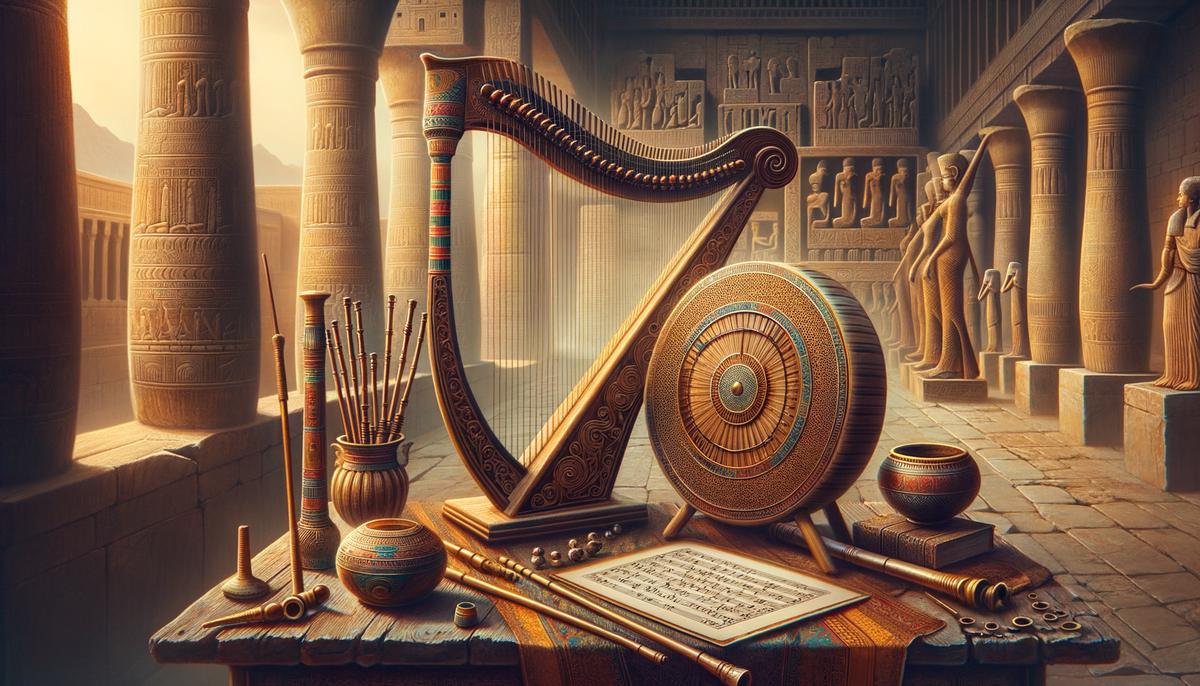
Instrument Types and Uses
The music of ancient times was heard through the cities of Mesopotamia and the monuments of Egypt, played on various instruments that served important roles within their societies.
In Mesopotamia, the captivating sounds of the oud—a precursor to the modern lute—filled the air. Carved from a single piece of wood and strung with gut or silk, the oud's somber yet melodious tones provided a backdrop to bustling markets and temple rituals. Its deep, resonant voice was believed to echo the voices of the gods, making it an essential part of divine ceremonies.
The steady beat of drums, made from animal skin stretched over earthen or metal vessels, marked the rhythm of Mesopotamian life, from agricultural cycles to military marches. Drums served as the pulse of ceremonies, synchronizing dancers' steps and elevating prayers, expressing communal unity and spiritual dedication.
In Ancient Egypt, the harp, with its elegant curve and shimmering strings, was a preferred choice among musicians. Larger than its Mesopotamian counterpart, the Egyptian harp could contain up to twenty strings, each capable of evoking emotion with its resonant tune.[2] Harpists frequently played at banquets and funerals, their melodies weaving through gatherings, believed to guide souls into the afterlife or entertain guests with stories of gods and heroes.
Flutes made of reeds or bones echoed the birds along the Nile and were often played in pairs by skilled musicians. The melodies produced were not only for leisure but also served in rites to honor the gods, particularly during the inundation when the Nile's floods were received with reverence and celebration.
Cymbals, made from bronze or brass, clashed in joyful noise during religious festivals, used in pairs to provide a sharp, piercing sound that could be heard through the crowds of worshipers. Their sound was used to startle and stir, invoking awe and attention at key moments within ceremonial proceedings.
In Mesopotamia and Ancient Egypt, musical instruments served purposes beyond mere entertainment. They were integral to daily life, providing comfort, signaling triumph, and ensuring divine favor. Instruments were means of communication between humans and the divine, bearing witness to life's moments and eternity's passage. Through strings, winds, percussions, and chimes, the ancient peoples communicated in a language that surpassed words, playing upon the essence of their cultures, leaving echoes that continue to intrigue us today.
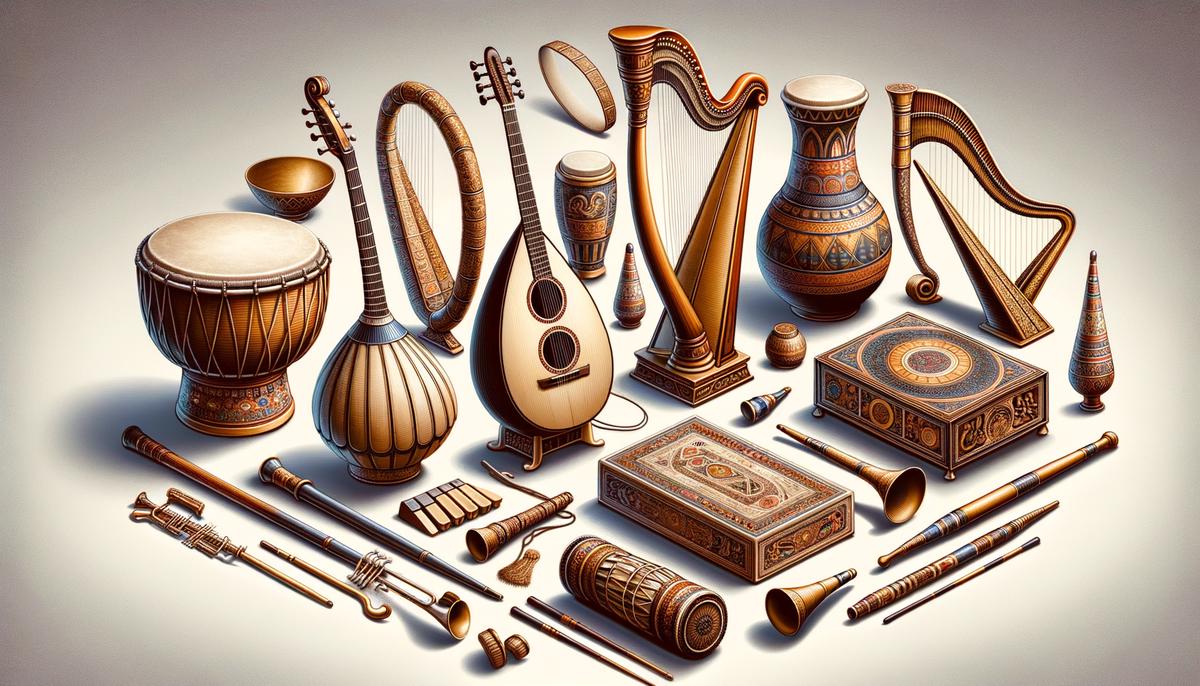
Craftsmanship and Materials
The composition of musical instruments in Mesopotamia and Ancient Egypt reveals a story of artistry, craftsmanship, innovation, and resourcefulness. In examining the materials used—woods, metals, animal skins, and reeds—one uncovers the relationship between humans and the natural world, reflecting patterns of cultural identity and technological advancement.
In Mesopotamia, where the Tigris and Euphrates rivers supported civilization, the selection of materials for musical instruments demonstrated their craftsmen's ingenuity. The respected lyres and harps, ornate in their appearance, often utilized woods like cedar or ash, chosen for their durability and sound quality. These wooden frames were intricately carved and strung with gut or silk, materials capable of producing delicate sounds.
The Mesopotamians showed an early understanding of acoustics, realizing that the selection of materials was closely tied to the sound quality these instruments produced. The blending tunes from golden flutes—crafted with an artisan's keen eye and a craftsman's steady hand—testified to the society's sophistication and its pursuit of musical refinement.
In Ancient Egypt, the crafting of musical instruments combined artistic flair and practical resourcefulness:
- The lotus and papyrus that grew along the Nile were used in making flutes and reeds, their natural structure allowing for the easy travel of air through hollow stems to produce notes that echoed across the sands of time.
- Harps and lyres incorporated wood, ivory, and bronze, showcasing a society comfortable with both modest and luxurious musical expressions.
The ancient Egyptians decorated percussive instruments like sistrums with fine metals and precious stones, signifying a developed craft and the embodiment of religious and cultural symbolism within the music. The lavish materials emphasized music's divine purpose, marking its presence in ceremonies and processions as both sacred and artistic.
The craftsmanship behind these ancient instruments reveals an awareness of material properties and their acoustic impacts, hinting at the advanced understanding of sound among ancient cultures. It reflects a connection with the environment, where resources were engaged with respectfully and integrated into cultural practices with reverence.
In analyzing the materials used in Mesopotamian and Ancient Egyptian musical instruments, one glimpses the ancient world's depth through the details embedded in strings, winds, and percussions. It is a testament to human creativity, an enduring melody of innovation, and interaction with the earth's resources, shaping our understanding of human history and nature's compositions.
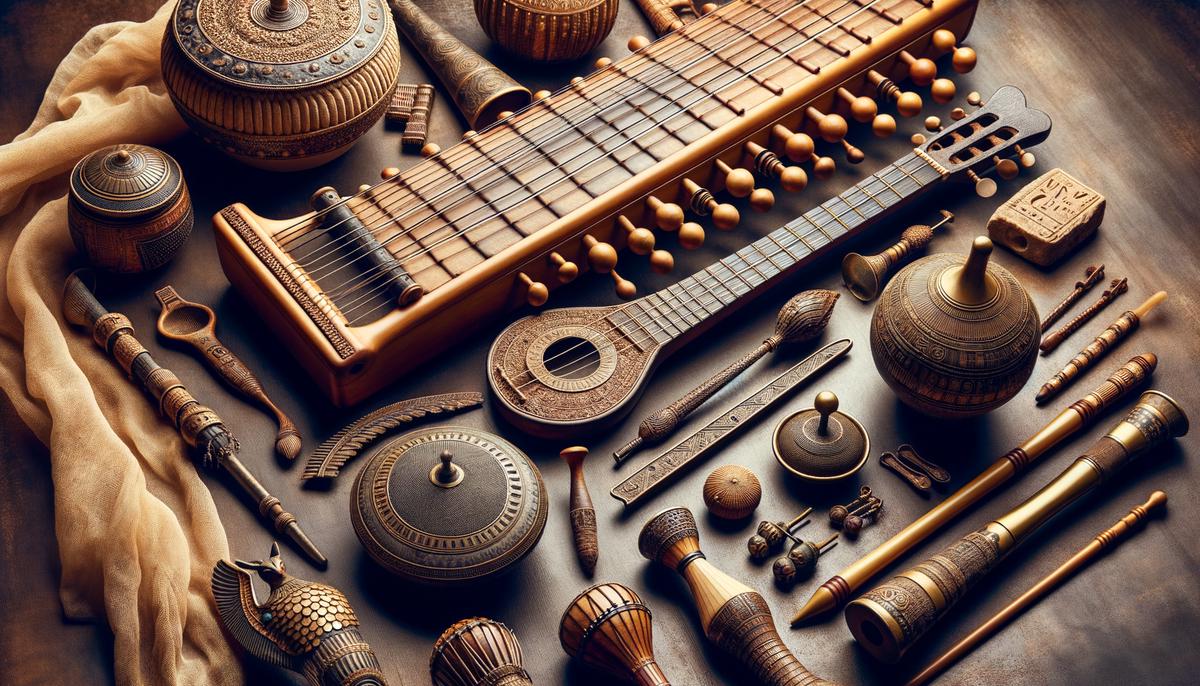
Musical Notation and Theory
The history of music in Mesopotamia and Ancient Egypt provides fascinating insights into early musical understanding, but navigating their knowledge is like deciphering a complex piece written in forgotten notes.
In Mesopotamia, music was conceptualized as both a divine gift and a sophisticated art form. The Sumerians, Akkadians, Babylonians, and Assyrians each contributed to the musical narrative. Cuneiform tablets suggest a theoretical understanding of music that foreshadows modern harmony and scales. These tablets hint at a numeric-based music system, wherein numbers assigned to string lengths on instruments like the lyre could have indicated pitch. The oldest form of musical notation was found here—a cuneiform tablet dating back to 1400 B.C., presenting a hymnic notation that outlines musical instructions for performance.[3]
In Ancient Egypt, music was conceptualized as an echo of cosmic order, intertwined with notions of harmony and balance inherent in Ma'at—their concept of truth, balance, and cosmic order. Their mythologies and deities, like Hathor, the goddess of love and joy, were connected with music-making. Illustrations from tomb walls and artifacts highlight a sophisticated engagement with music.
Evidence suggests the Egyptians applied a mnemonic system, relying on text and/or verbal instruction accompanying instrumental performances. Similar to how contemporary musicians might write down a chord sequence without standardized notation, Egyptian musicians likely used an informal system for teaching and sharing music. Instructions for how a piece should feel or the mood it should convey possibly accompanied these teachings, reflecting a world where oral traditions were important.[4]
The method through which music was taught and transmitted in both Mesopotamian and Ancient Egyptian societies reflects a combination of sophistication and simplicity. Apprenticeships under master musicians, participation in temple rites, and family traditions likely served as ways for learning. Music was woven into the fabric of daily life, present within ritualistic, educational, and leisurely domains.
Understanding musical theory and transmission in Mesopotamia and Egypt brings us closer to comprehending these ancient societies. Their approach to music reveals societies that respected art's power to connect the human with the divine, balance with chaos, emotion with reason—a musical legacy that continues to resonate today.
Examining musical theory and transmission in Mesopotamia and Egypt demonstrates that music was a cornerstone of culture, tied to their philosophies, cosmologies, and daily lives. As we continue to uncover these ancient tones and tunes, it's a reminder that the human connection to music transcends time, echoing from the past into our modern world.
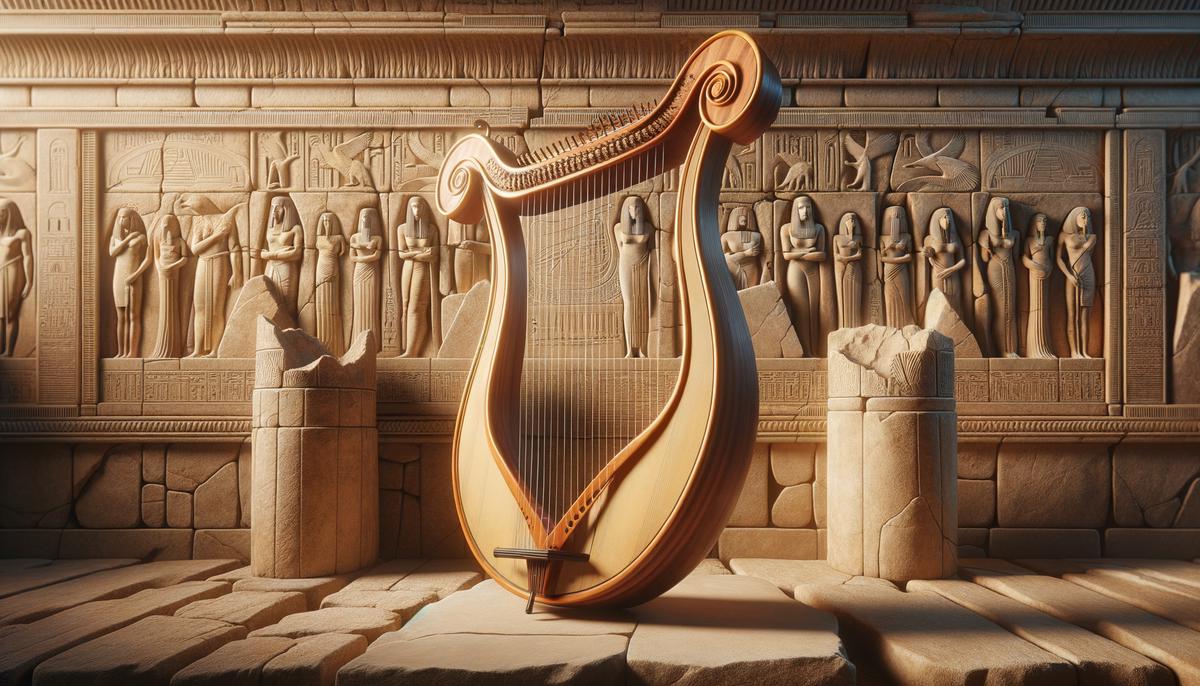
Influence on Modern Instruments
The journey of music from Ancient Egypt and Mesopotamia to modern times is a remarkable tale of evolution, innovation, and resonance. Mesopotamian and Ancient Egyptian musical instruments have influenced modern music and music theory, echoing through time to shape contemporary sounds and instruments.
In the realm of strings, the Mesopotamian lyre can be traced through history to present-day stringed instruments. The guitar, with its harmonic versatility and ubiquity in modern music, owes structural inspiration to the ancient lyre's design. Instrument makers in Ancient Egypt and Mesopotamia realized that varying the length and tension of strings could produce diverse sounds, a principle fundamental to the development of guitars, violins, and harps. Today's luthiers continue to explore the complex mathematics of harmony and tension first investigated millennia ago.
The ancient Egyptian flutes find their descendants in the orchestral flutes that grace modern symphonies. The principle of creating sound by directing air over a sharp edge has traversed the ages virtually unchanged. Modern flutes, clarinets, and saxophones share this breathy essence with their ancient predecessors, proving that some sonic truths are universal.
The notational efforts seen in cuneiform tablets from Mesopotamia lay foundational stones for modern music theory. The Mesopotamians' early explorations into musical intervals ignited the flame that would light the way for Pythagoras' revelations about harmonics, suggesting an intriguing lineage of thought that informs the harmonic laws governing contemporary music theory.
Ancient Egypt's mnemonic approach to musical instruction, emphasizing oral transmission and memorization, finds echoes in modern music education. The value of ear training, improvisation, and learning by rote remains important. Jazz, blues, and many traditional music forms continue to flourish through oral tradition, combining written music with the spontaneity of improvisation.
In percussion, the evolutionary line from ancient drums to contemporary instruments underscores humanity's timeless affinity for rhythm. Ancient drums, crafted from animal hides and wood, metaphorically beat the pulse of human history into modern drum kits that sit at the heart of countless genres.
The legacy of Mesopotamian and Ancient Egyptian musical instruments on modern music and theory is a testament to the continuity of human ingenuity. It affirms that while our civilizations have transformed, our love for music remains a constant thread woven through the fabric of human experience. As we play guitar strings or key melodies into synthesizers, we engage in age-old conversations, joining our voices with those who first discovered music's enchanting power under ancient skies.
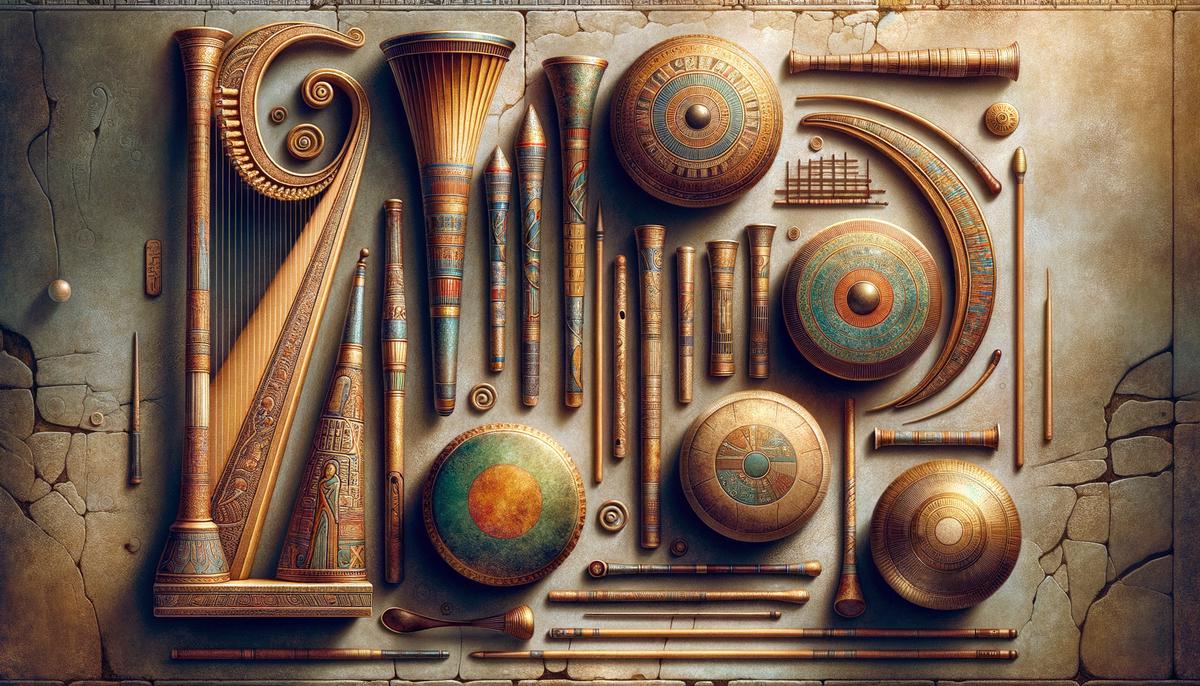
- Arroyo RPT. Egypt: Music in the Age of the Pyramids. National Geographic Music. 2003:536-545.
- Lawergren B. Strings. In: Sadie S, Tyrrell J, eds. The New Grove Dictionary of Music and Musicians. 2nd ed. New York, NY: Oxford University Press; 2001:612-620.
- Dumbrill R. The Musicology and Organology of the Ancient Near East. London, UK: Tadema Press; 1998:245-261.
- Schoville KN. The Role of Oral Tradition in Ancient Near Eastern Music. Journal of Near Eastern Studies. 1985;44(1):31-38.
























